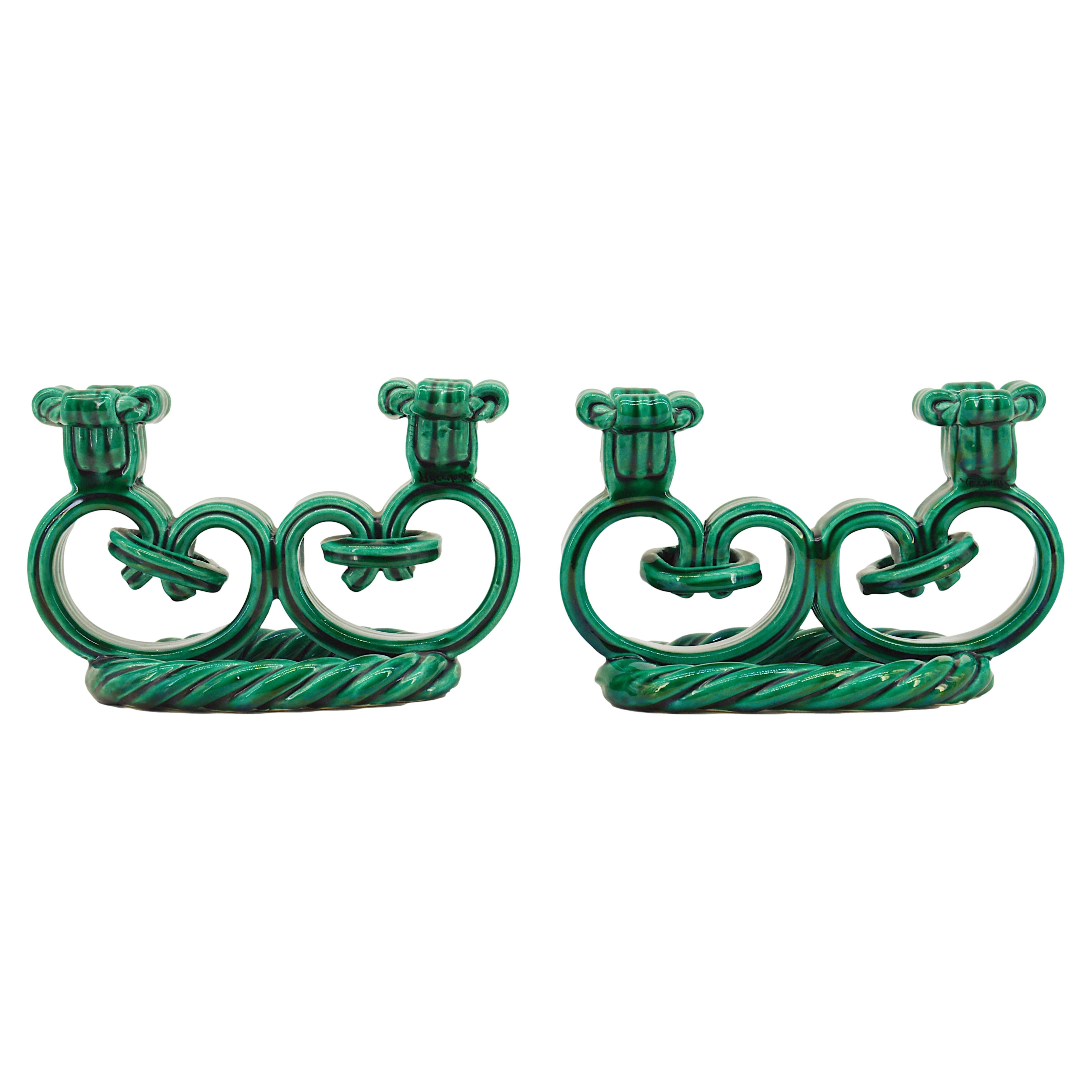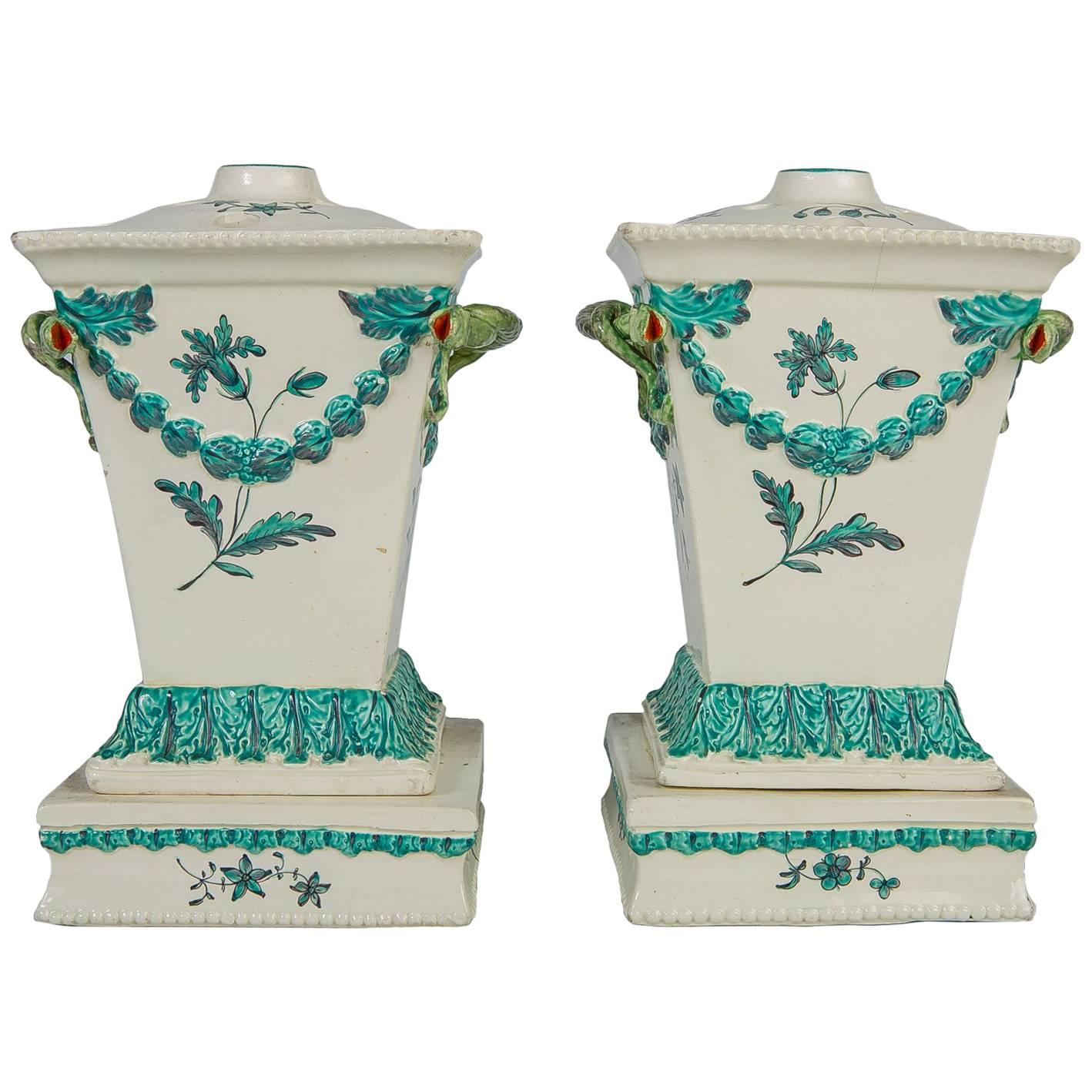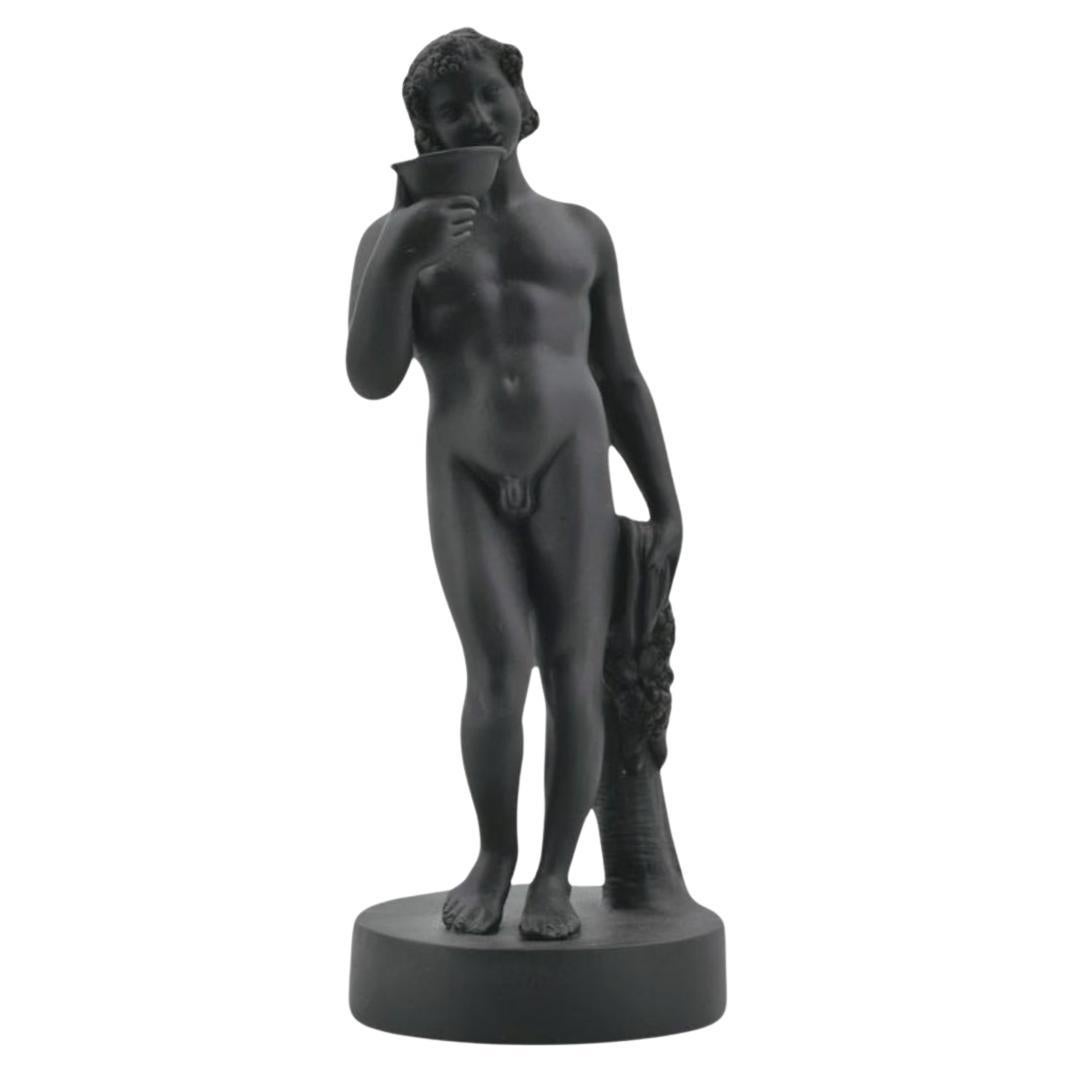Items Similar to Pair of Triton Candlesticks. Palmer C1780.
Want more images or videos?
Request additional images or videos from the seller
1 of 7
Pair of Triton Candlesticks. Palmer C1780.
About the Item
An exceptionally rare pair of Triton candlesticks, in black basalt with gold lustre. The design is copied from Wedgwood, who took it from Sir William Chambers' study of Bernini's Triton Fountain, in the Piazza Barbarini.
An unscrupulous dealer (not me) has had them fixed to early Wedgwood bases, in an attempt as passing them off. They are certainly by Palmer; but they do go sit well on the bases.
- Creator:Palmer (Manufacturer)
- Dimensions:Height: 10 in (25.4 cm)Width: 4 in (10.16 cm)Depth: 4 in (10.16 cm)
- Style:Neoclassical (Of the Period)
- Materials and Techniques:Stoneware,Molded
- Place of Origin:
- Period:
- Date of Manufacture:circa 1780
- Condition:Replacements made: Bases have been replaced with Wedgwood bases.
- Seller Location:Melbourne, AU
- Reference Number:
About the Seller
5.0
Vetted Seller
These experienced sellers undergo a comprehensive evaluation by our team of in-house experts.
Established in 2005
1stDibs seller since 2017
69 sales on 1stDibs
Typical response time: 3 hours
- ShippingRetrieving quote...Ships From: Melbourne, Australia
- Return PolicyA return for this item may be initiated within 14 days of delivery.
More From This SellerView All
- Encaustic Painted Teapot in Black Basalt, Wedgwood C1780By WedgwoodLocated in Melbourne, VictoriaA rare and stunning example of neo-classical decoration on an ordinary househuld object: a teapot. The decoration is restrained yet lively, and makes excellent use of classical figur...Category
Antique Late 18th Century English Neoclassical Ceramics
MaterialsStoneware
- Black basalt figure of Bacchus. Wedgwood C1780.By WedgwoodLocated in Melbourne, VictoriaExceptionally rare early figure of Bacchus in black basalt. The mixed-case mark places this figure between 1780 and 1785. He is portrayed in typical style, his head garlanded with g...Category
Antique 1780s English Neoclassical Pottery
MaterialsStoneware
- Tea Canister, Hop Trellis Pattern, Worcester, C1780By 1st Period Worcester Dr. WallLocated in Melbourne, VictoriaIn soft paste porcelain, French shape, decorated with a variation of the scarce and popular Hops and Trellis pattern. Prov. Lady Humphries collection....Category
Antique Late 18th Century English Neoclassical Porcelain
MaterialsPorcelain
- Navette, with Ladle, Wedgwood, C1790By WedgwoodLocated in Melbourne, VictoriaAn extraordinary navette, or cream boat, in black basalt with encaustic decoration. Complete with matching ladle: a rare find indeed.Category
Antique Late 18th Century English Neoclassical Ceramics
MaterialsStoneware
- Basket-Weave Teapot in Black Basalt, Wedgwood C1790By WedgwoodLocated in Melbourne, VictoriaA most attractive and unusual teapot in black basalt, moulded with basket-weave decoration and interlocking arches. Exhibited: Wedgwood, Master Potter to the Universe, Roche Foundat...Category
Antique Late 18th Century English Neoclassical Ceramics
MaterialsStoneware
- Black Basalt Tea Canister with Applied Decoration, Mayer, C1790By Elijah Mayer PotteryLocated in Melbourne, VictoriaCyclicrical tea canister in engine-turned black basalt, with raised decoration. Unmarked, but the quality and finial clinch the attribution.Category
Antique Late 18th Century English Neoclassical Ceramics
MaterialsStoneware
You May Also Like
- Vallauris Pair of Candlesticks, 1940sBy André BaudLocated in Saint-Amans-des-Cots, FRPair of candlesticks made at Vallauris, France, 1940s. Ceramic. Representation of braided candlesticks, Classic design from this period of the 40s. Very close to the work of Jérome M...Category
Vintage 1940s French Neoclassical Candlesticks
MaterialsCeramic
- Two Pairs of Italian Maiolica Baskets, circa 1780By Antonio FerrettiLocated in Milano, ITTwo pairs of maiolica baskets Antonio Ferretti Manufacture Lodi, circa 1770-1790 Maiolica polychrome decorated “a piccolo fuoco” (third fire). Measures: A) Height 3.54 x 6.69 x 9.84 in (9 x 17 x 25 cm); B) Height 3.93 x 7.48 x 11.02 in (10 x 19 x 28 cm). Total weight 4.85 lb (2.200 kg) State of conservation: A) One of the smaller baskets has some areas of restoration, the other slight chipping from use; B) One of the larger baskets is intact and the other shows a clearly glued break. The mold with which the baskets were forged simulates a wicker weave. The two larger works have high, vertical walls, with branch-shaped handles penetrating the weave. The painted decorations, small polychrome flowers applied only externally, highlight the points where the weaves intersect. The decision to leave the center of the basket devoid of decoration is highly unusual, but given the size and complexity of the shape, as well as the quality of the enamel, it is possible to hypothesize that it represents a precise choice in manufacturing or for a particular client. The two smaller baskets have small, twisted handles and, on the outside, reproduce more decisively the characteristic wicker weave, obtained through thin molded lines. The interior exhibits a rich, typical decoration of naturalistic flowers: a bunch centered around a main flower and secondary stems accompanied by small “semis”. The exterior of these works is also adorned with small little flowers where the weaves intersect. The size and morphological characteristics of the baskets confirm their attribution to the Lodi factory of Antonio Ferretti between 1770 and 1790, during its most successful period; by this point his original reworking of the "Strasbourg" decoration, known as "old Lodi", had achieved great fame even outside Italy. This decorative choice represented a strong point of the Lodi factory, which established itself thanks to the vivid nature of the colors made possible by the introduction of a new technique perfected by Paul Hannong in Strasbourg and which Antonio Ferretti introduced in Italy. This production process, called “piccolo fuoco” (third fire), allowed the use of a greater number of colors than in the past; in particular, the purple of Cassius, a red made from gold chloride, was introduced. Its use allowed for many more tones and shades, from pink to purple. The Ferretti family had started their maiolica manufacturing business in Lodi in 1725. The forefather Simpliciano had started the business by purchasing an ancient furnace in 1725 and, indeed, we have evidence of the full activity of the furnaces from April of the same year (Novasconi-Ferrari-Corvi, 1964, p. 26 n. 4). Simpliciano had started a production of excellence also thanks to the ownership of clay quarries in Stradella, not far from Pavia. The production was so successful that in 1726 a decree of the Turin Chamber came to prohibit the importation of foreign ceramics, especially from Lodi, to protect internal production (G. Lise, La ceramica a Lodi, Lodi 1981, p. 59). In its initial stages, the manufacture produced maolicas painted with the “a gran fuoco” (double fire) technique, often in turquoise monochrome, with ornamentation derived from compositional modules in vogue in Rouen in France. This was also thanks to the collaboration of painters like Giorgio Giacinto Rossetti, who placed his name on the best specimens next to the initials of the factory. In 1748 Simpliciano made his will (Gelmini, 1995, p. 30) appointing his son Giuseppe Antonio (known as Antonio) as universal heir. After 1750, when Simpliciano passed away, Antonio was directly involved in the maiolica factory, increasing its fortunes and achieving a reputation on a European level. Particularly important was the aforementioned introduction in 1760 of the innovative “a piccolo fuoco” (third fire) processing, which, expanding the ornamental repertoire with Saxon-inspired floral themes, could commercially compete with the German porcelains that had one of its most renowned offerings in the naturalistic Deutsche Blumen. Antonio Ferretti understood and promoted this technique and this decoration, proposing it in a fresher and more corrective version, less linked to botanical tables...Category
Antique 1770s Italian Neoclassical Ceramics
MaterialsMaiolica
- Creamware Pair of English Flower Holders, 18th Century circa 1780By Neale & Co.Located in Katonah, NYWHY WE LOVE IT: One of our absolute favorites! A pair of 18th-century creamware flower holders complete with stands and covers made in England by Neale & Co. was one of the finest 18...Category
Antique Late 18th Century English Neoclassical Vases
MaterialsCreamware
- Pair of Vienna Green Ground Ice Pails, circa 1780Located in New York, NYWith covers and liners. Marked with under glaze blue shield mark.Category
Antique 1780s Austrian Serving Bowls
MaterialsPorcelain
- Gustavsberg a Pair of Unglazed Candlesticks, app. 1960sBy Stig LindbergLocated in Copenhagen, DKGustavsberg. A pair of unglazed candlesticks in stoneware. Approximately 1960. Marked. Measures 13 cm. In perfect condition.Category
Vintage 1960s Swedish Scandinavian Modern Ceramics
- Georgian 'Lacemaker's' Lamp c1780By Georgian House 1Located in Tunbridge Wells, GBHeading : A Georgian 'lacemaker's' lamp c1780 Date : c1780 Origin : England Colour : Clear, grey hue Pontil : Snapped Glass Type : Lead Size : 14.2cm tall, 10.5cm diameter Condition ...Category
Antique 1780s British George III Glass
MaterialsBlown Glass
Recently Viewed
View AllMore Ways To Browse
Gold Lustre
Early Wedgwood
Black Basalt
Antique Glass Lustres
Wedgwood England Black
Wedgwood 18th
18th Century Wedgwood
Antique Black Wedgwood
18th Century Stoneware
Gold Wedgwood
Wedgwood Basalt
Wedgwood Black Basalt
Gold And Black Candlestick
Candlestick Gold Black
Pair Glass Lustres
Lustre Candlestick
Pair Basalt
Gold Palmer





